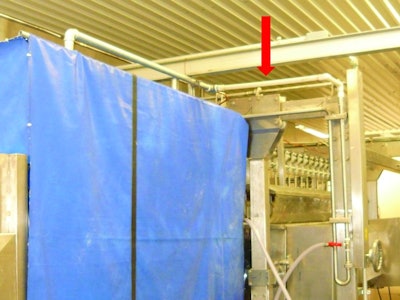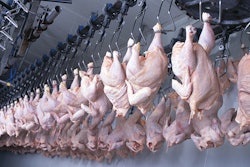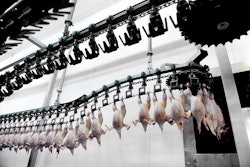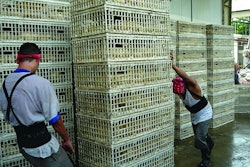
There are numerous operations in poultry processing that need regular auditing to ensure that they are functioning as well as they should. For those tasked with doing this, they will need a thorough understanding of each operation. Additionally, they will need to develop the habit of not only being aware of obvious issues, but they will also need to seek out less obvious problems.
Developing a good working relationship with plant employees and encouraging them to communicate problems transparently is also highly beneficial, and this open dialogue can help not only in uncovering issues but also in finding workable solutions.
There are a number of areas in particular where those monitoring operations need to pay particular attention.
Broiler washing, brushing prior to scalding
To reduce the organic load in scalders, installing carcass washing and brushing equipment should be considered. These machines are similar to those used to remove feathers and other residue from empty shackles.
Cylindrical brushes through which pass sprayed water can remove both dry and moist fecal material adhered primarily to the feathers and skin. This system will also remove dust, considered a contaminant, helping to reduce the organic load in the scalders.
In countries where disinfectants are permitted, some plants add, among other products, sodium hydrochlorite, with doses up to 40 ppm, or ammonia, to the sprayed water.
Successful use of a washer brusher can result in significant water and other savings and will improve the sanitary conditions of the scalder water and reduce cross-contamination risks.
Scalding
The temperature of the scalder water, and the time that carcasses spend in it, will determine whether broilers exit it with or without the epidermis.
Scalder water turbulence must be uniform. To achieve this, the air inlets must be correctly adjusted to ensure that birds do not rise to the surface during their passage through the scalder as this will affect scald efficiency. Birds need to be completely submerged to ensure ease of feather removal, particularly those of the tail and wings.
Scalder water needs to be replaced at a volume of 1 liter per bird. Should water levels drop below required levels, the follicles of those feathers that spring from muscle may not open, necessitating manual feather removal.
Water temperature should be similar throughout the tank, however, a variation of ± 0.3 C is acceptable.
Route from scalder exit to first plucker
When birds exit the last scalder their external breast temperature should be monitored. Generally, it should be around 45 C and a laser thermometer can be used to ascertain this.
If the distance between the scalder exit and entry to the first plucking machine is less than approximately 1 meter, there will be no need to cover the route with a plastic or stainless-steel covering. However, once the distance exceeds 1.5 meters it may be advisable to install a canopy to prevent surface heat being lost. Should the temperature of this section of the plant be particularly low, it may be necessary to install a sprinkler with water at 45 C.
Plucking
The prior operations must have been completed well if plucking is to be successful. If not, plucking may result in skin tears or wing dislocation.
The number of plucking fingers used should be equal to, or lower than, the international standard for monthly rubber finger consumption, i.e. one finger for every 2,000 birds processed.
To achieve successful plucking a number of factors need to be considered.
Water, to keep the fingers free from feathers, should be at a temperature of 34-38 C.
Fingers need to be inserted into the disks taking into account broilers anatomy and that the wing and tail feathers are the hardest to remove.
Finger condition needs to be checked on a daily basis at the end of each shift, with worn, split or fallen fingers replaced. This will help to ensure evenness of wear.
Some plucking machines use metal disks to hold the fingers. In this case the disk holes, where the fingers sit, must not have sharp surfaces. Should this be the case, fingers will be cut and eventually fall to the floor.
To ensure that rubber fingers are being used efficiently, the number of replacements needs to be logged.
Disk line speeds must be regulated to reflect the age of the birds being plucked and the part of bird with which the fingers will have contact.

Leg and shackle issues
Rigid shackles are used to transport birds in most plants, and this can cause difficulties due to the varying thicknesses of broilers’ legs. This may result in birds not being properly placed in the shackles, and this can affect stun quality. There are, however, some companies that are able to adapt these commonly used rigid shackles.
Evisceration
This part of processing has its own, distinct, characteristics that must be monitored to prevent quality issues that may affect the final dry yield.
When using the vent extractor and cutting the abdomen, care must be taken to avoid cutting the intestines and the abdominal fat.
Similarly, care must be taken not to damage the liver when removing the intestinal package.
When removing the gallbladder, care must be taken to avoid carcass staining.
Where the gizzard is concerned, adhered gizzard fat must be left in the carcass. Gizzard peeling must be performed with great care, and warm water can facilitate this.
The neck cut must be as straight as possible.
Chilling
Chilling comprises pre-chilling and chilling.
During pre-chilling, the water should be at room temperature, 26-30 C when the plant is located in a hot climate. The eviscerated birds enter the water with a temperature of around 38 C and, in these conditions, follicles remain open, making water absorption easier. Continuous water turbulence is needed, and carcasses should remain submerged for 30-45 minutes.
For chilling, the water temperature should be in the range of 0-2 C, permitting the carcasses to reach a temperature gradient of 2 C, equivalent to 2-4 C. Total immersion and even water turbulence will result in internal carcass temperatures equivalent to those above. On exiting the chiller, bacterial growth is significantly slowed as is the start of exudation.















